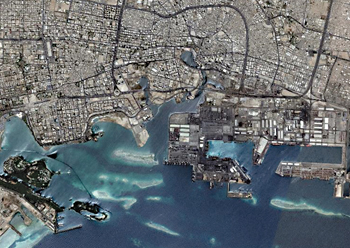A city with many centres
Jeddah’s landscape is fast changing with developers aiming to turn the city into a 21st century vertical urban centre.
01 December 2018
The city of Jeddah will become polycentric when some of the boldest masterplanned developments unfold over the course of the next decades, the CEO of the company that is spearheading the construction of the world’s tallest tower told a recent conference in Dubai, UAE.
This will come about as the result of very ambitious private and public sector initiatives, Mounib Hammoud, the CEO of Jeddah Economic Company (JEC) – which is building the 1-km-plus Jeddah Tower – stated at the Council on Tall Buildings and Urban Habitat (CTBUH) 2018 conference in late October.
The theme of the CTBUH conference was ‘Polycentric Cities: The Future of Vertical Urbanism’, which approached the new normality of mega cities housing 10 million or more inhabitants. The conference highlighted that the cities best positioned for the future are evolving along polycentric, multi-nodal lines, with several central business districts, ideally all offering something slightly different to the urban inhabitant.
.jpg) |
|
An artist impression of Jeddah Economic City ... a smart, environment-friendly, resort-like, mixed-use city. |
In his presentation entitled Urban Oases: Generating Polycentric Cities in the Middle East, Hammoud said he is an advocate of polycentrism. While earlier it was believed that high-rises were built in response to high land values, “all that has been turned on its head, and we compete to build landmark high towers in order to create high land values. This inversion is now a well-established trick of urban development. Around the iconic towers, we plan nodes of development to enhance the visibility of certain locations,” he indicated.
“This is certainly the case in Jeddah, where the next ‘world’s tallest tower’ is intended to inform a new node of development, 147 million sq ft of masterplanned real estate, on land that is located on the Red Sea, way beyond the old centre,” Hammoud added.
He pointed out that Jeddah is a port city, a place of very traditional culture, and has an ancient, fine vernacular old city centre. However, the city has spread 40 km northwards, hugging the coastline, only 10 km wide, on a highway grid which dices the city into separated districts, which cannot be walked one-to-another.
Jeddah is polycentric in its own way with clustered districts between highways. “But with few exceptions, these are main-drag-type locations. The old city centre is in the south. The old airport site is under redevelopment. And there are numerous large, gated or exclusive residential developments. The real poles of attraction are the retail strips and shopping malls. They attract huge footfall.
 |
|
An overview of Jeddah ... the city has spread 40 km northwards, hugging the coastline. |
“In each district, the service road of the main highway became a retail location and the hinterlands became the residential quarters, in which villas house multi-generational families. People have followed the trend, and moved ever further northwards. The south is industrial, the west is the sea and the east is the desert,” Hammoud explained.
“But the real positive change came with the Vision 2030, the lifestyle and requirements of 70 per cent of the Saudi population under 30 years old is in play. With subsidies reduced on water, electricity and petrol, mixed-use live-work-play centres are the future. Apartment living will prevail,” he added.
When JEC designed Jeddah Economic City in 2013 – which will be anchored by the Jeddah Tower – the company was ahead of the trend, because it had an ambition for the new ‘city’ at North Obhur.
“We conceived this as not only the new centre of Jeddah – but also a smart, environment-friendly resort-like, mixed-use city to meet the expectations of young Saudis and offer an advanced quality of life.
“We have used the best urban planners, the best architects and engineers and we have designed a walkable cityscape, with high quality infrastructures and landscaped public domain with guidelines for secondary developers which will create a coordinated, harmonious city centre,” he emphasised.
Associated with public transport, a landscape of towers will foster a new, enjoyable and affordable habitation. Offices for larger companies and small and medium enterprises (SMEs) will establish the business component of the city. Visitors will be attracted to the hotels, the super-regional shopping mall and the animated water body for leisure and entertainment. There will be cultural components, educational offerings and public amenities.
“The project will offer more than 30,000 new job opportunities just in Phase One.
“So there will come about a transformation in the way people live – we believe greatly for the better. In addition, the city of Jeddah appears to becoming spontaneously polycentric. Other centres in Jeddah are emerging, all megaprojects, and each widely dispersed. These include the Emaar midtown heart of Jeddah project, which will anchor the city in the mid-east section; the new Public Investment Fund project on the seaside next to the Jeddah fountain which will anchor the mid-west; and the Airport City south of the airport.
“Our project Jeddah Economic City – the greatest node of all – will be the new anchor of North Jeddah.
“If and when all the centres achieve maturity, it will definitely decelerate the speed of the growth of city towards the north, and there will be a long period of consolidation in and around the centres,” he concludes.


.jpg)
